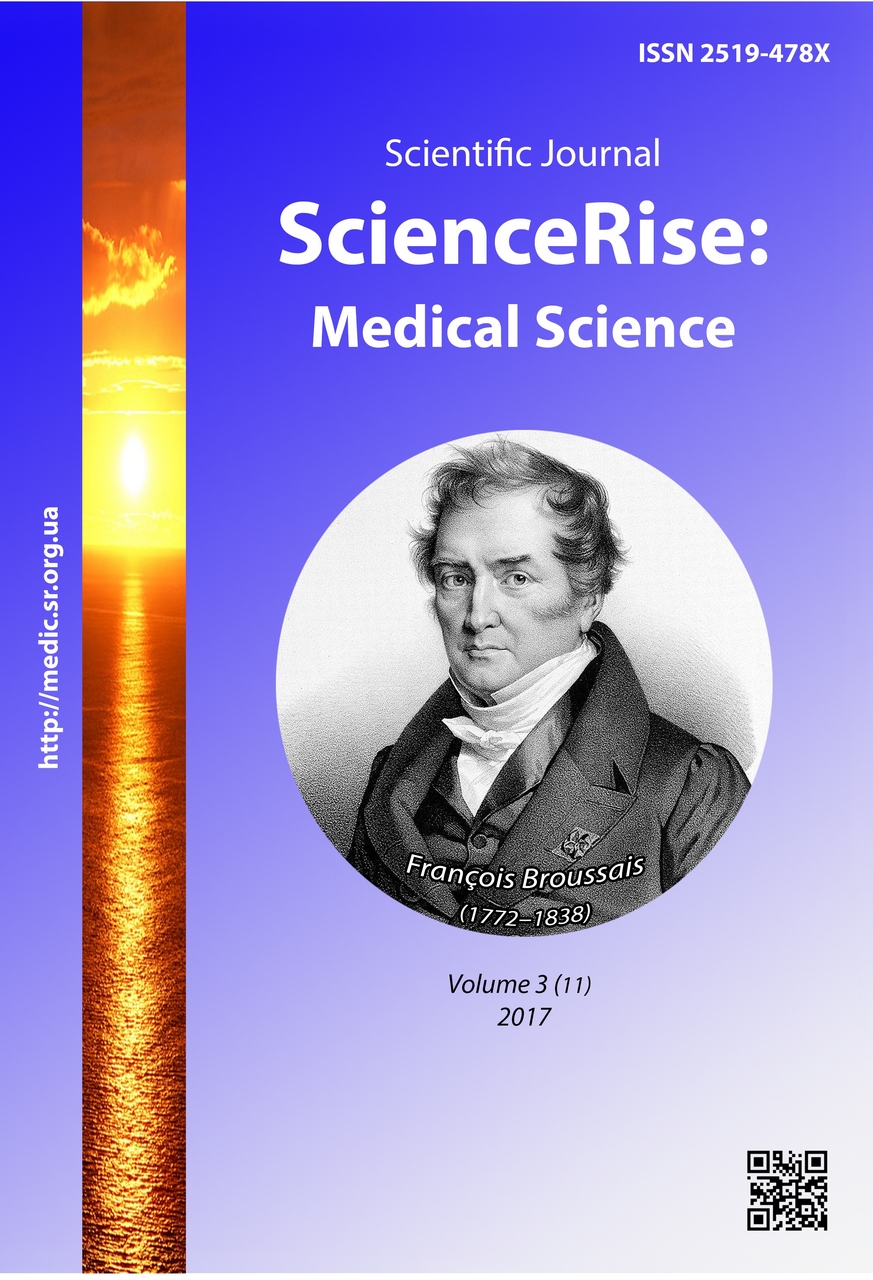Analysis of the pathopersonological stratifications in patients with severe diabetes mellitus 2 type
DOI:
https://doi.org/10.15587/2519-4798.2017.97077Keywords:
diabetes mellitus type 2, pathopesonology, psychopathic disorders, complianceAbstract
Aim. To study the pathopersonological features of patients with severe DM type 2 for improvement of diagnostics and treatment of patients with DM type 2.
Materials and methods. On the bases of MI “Zaporizhzhya city hospital № 1” and MI “Regional clinical endocrinology dispensary” of Zaporizhzhya region council were examined 174 patients with severe diabetes mellitus type 2, who underwent stationary treatment; average age in group was (61,8±0,85) years old.
Methods of research: anamnestic, clinical-psychopathological, psychodiagnostic.
Results of research. As a result of research, the pathopersonological features of patients with severe diabetes mellitus type 2 were established. There were separated five types of pathopersonological stratifications in patients with severe diabetes mellitus type 2: psycho-organic (deficit and affective-labile variants), astheno-neurotic, psychastheno-depressive, ergo-hypersthenic and hypochondriac types. The influence of each established type of pathopersonological stratifications in patients with severe diabetes mellitus type 2 on their compliance to the therapy was studied. The dominant types of of pathopersonological stratifications in patients with severe diabetes mellitus type 2 were established.
Conclusions. The established types of pathopersonological stratifications in patients with severe diabetes mellitus type 2 can be a base of diabetic pathopersonology that improves the quality of differentiated diagnostics and approaches to the therapy and psychoprophylaxis of DM type 2, including in the context of correction of compliance to the therapy of DM type 2 at the expanse of dyscompliant personal features leveling
References
- Brojtigam, V., Kristian, P., Rad, M. (1999). Psihosomaticheskaja medicina. Moscow: GJeOTAR MEDICINA, 376.
- Jaacks, L. M., Siegel, K. R., Gujral, U. P., Narayan, K. M. V. (2016). Type 2 diabetes: A 21st century epidemic. Best Practice & Research Clinical Endocrinology & Metabolism, 30 (3), 331–343. doi: 10.1016/j.beem.2016.05.003
- Meetoo, D., McGovern, P., Safadi, R. (2007). An epidemiological overview of diabetes across the world. British Journal of Nursing, 16 (16), 1002–1007. doi: 10.12968/bjon.2007.16.16.27079
- The Protocol of rendering medical care to patients not complicated by diabetes (2009). Ministry Healthcare of Ukraine, No. 574. Available at: http://www.moz.gov.ua/ua/portal/dn_20090805_574.html
- Unified clinical protocol of primary, emergency, secondary (specialized) and tertiary (highly specialized) medical care. Diabetes in young people and adults (2014). Ministry Healthcare of Ukraine, No. 1021. Available at: http://mtd.dec.gov.ua/images/dodatki/2014_1021_CD1_dor/2014_1021_nakaz_CD1_dor.pdf
- Degmecic, D., Bacun, T., Kovac, V., Mioc, J., Horvat, J., Vcev, A. (2014). Depression, anxiety and cognitive dysfunction in patients with type 2 diabetes mellitus – a study of adult patients with type 2 diabetes mellitus in Osijek, Croatia. Collegium Antropologicum, 38 (2), 711–716.
- Esin, R. G., Hayrullin, I. H., Esin, O. R. (2013). Modern ideas about the mechanisms of cognitive disorders in diabetes mellitus. Medical almanac, 1 (25), 135–138.
- Harris, M. I., Flegal, K. M., Cowie, C. C., Eberhardt, M. S., Goldstein, D. E., Little, R. R. et. al. (1998). Prevalence of diabetes, impaired fasting glucose, and impaired glucose tolerance in U.S. adults. Diabetes Care, 21 (4), 518–524. doi: 10.2337/diacare.21.4.518
- Lou, P., Qin, Y., Zhang, P., Chen, P., Zhang, L., Chang, G. et. al. (2015). Association of sleep quality and quality of life in type 2 diabetes mellitus: A cross-sectional study in China. Diabetes Research and Clinical Practice, 107 (1), 69–76. doi: 10.1016/j.diabres.2014.09.060
- Bezbach, V. N. (2005). Strategiya lecheniya i osobennosti kliniki psihicheskih rasstroystv i psihosotsialnyih problem u bolnyih saharnyim diabetom. Sotsialno psihiatricheskie aspektyi saharnogo diabeta. Mezhdunarodnyiy endokrinologicheskiy zhurnal, 1 (1). Available at: http://www.mif-ua.com/archive/article/2296
- Zelenin, К. А., Kovalev, Yu. V., Trusov, V. V. (2010). Anxiety disorders in patients with 2 type diabetes mellitus. Вasic research, 7, 24–31.
Downloads
Published
How to Cite
Issue
Section
License
Copyright (c) 2017 Olga Tkachenko

This work is licensed under a Creative Commons Attribution 4.0 International License.
Our journal abides by the Creative Commons CC BY copyright rights and permissions for open access journals.
Authors, who are published in this journal, agree to the following conditions:
1. The authors reserve the right to authorship of the work and pass the first publication right of this work to the journal under the terms of a Creative Commons CC BY, which allows others to freely distribute the published research with the obligatory reference to the authors of the original work and the first publication of the work in this journal.
2. The authors have the right to conclude separate supplement agreements that relate to non-exclusive work distribution in the form in which it has been published by the journal (for example, to upload the work to the online storage of the journal or publish it as part of a monograph), provided that the reference to the first publication of the work in this journal is included.









